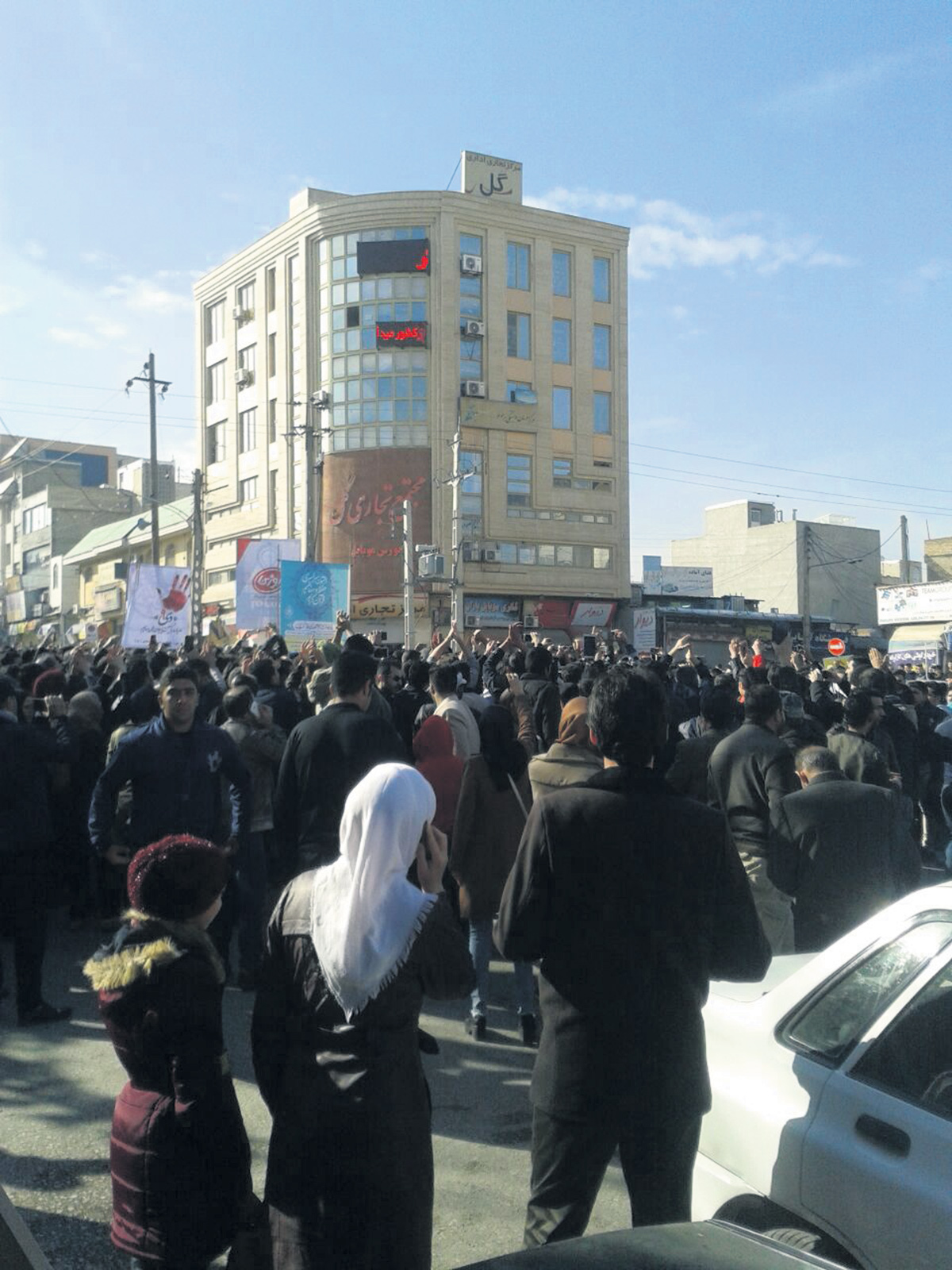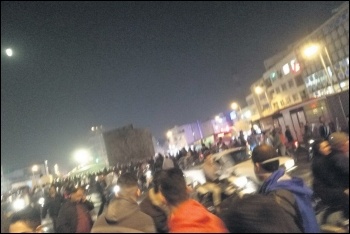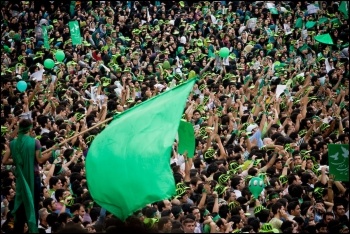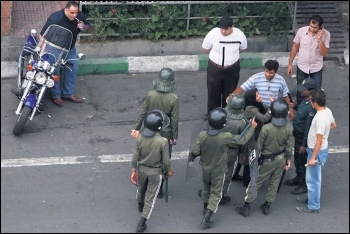Movement of workers and youth challenges Iranian regime
Young people and workers have taken to the streets against Iran’s theocratic regime (Click to enlarge: opens in new window)
P. Daryaban, Committee for a Workers’ International (CWI)
Sudden large scale nationwide protests have shaken Iran. Sections of the population have shown utter defiance of the regime. Young people in particular, facing unemployment estimated at between 25% and 40%, have been to the fore.
The protests, initially against the price rises and corruption, almost immediately developed into clashes with security forces, with a mounting death toll.
In some cities, people attacked police stations, pro-regime paramilitary headquarters and religious seminaries.
The immediate spark was opposition to December’s announcement of more neoliberal policies by the ‘moderate’ president, Hassan Rouhani, as well as a sharp rise in staple goods’ prices alongside the publication of details of the increased lavish financing of religious bodies.
With continuing mass unemployment and an average 15% drop in living standards over recent years, the protests spread rapidly across the country.
The economic crisis has deepened over the last few years. This is seen in the huge debts of the government to banks, the depletion of resources of pension funds, the bankruptcy of financial institutions and an unbelievable amount of corruption and embezzlement, which has directly damaged working class living conditions. This, along with the growing visibility of a wealthy elite, was another key factor in these protests, which heard calls of “down with the embezzlers!”
The Rouhani administration boasted about reducing inflation to single digits and increasing the growth rate to 6%. However, the first was partially achieved by neoliberal measures, while the second was just the product of the regime’s ability to export oil after a part of UN-imposed sanctions were lifted.
The regime has also depleted its resources by involving itself in wars in Iraq, Syria and Yemen. Additionally the Lebanese Hezbollah leader openly announced that they receive all the money for their party and for improving infrastructure in South Lebanon from Iran. The regime pays huge funds to the military forces it backs in Iraq too.
The regime, for a while, sought justification through fearmongering about the emergence of terrorism inside Iranian borders etc. However, with the fall of Isis, the regime’s bogeyman has largely disappeared, at least for now.
US president Donald Trump’s coming into office aggravated the situation and shattered the Iranian regime’s dreams of attracting foreign investments. Iranian banks have not been able to return to the international banking system.
During the last three or four years, two major movements kept the flame of opposition alight – the workers’ movement and the campaign by depositors in bankrupt financial institutions.
Major strikes and pickets took place in Arak in north-western Iran and in the oil and gas rich areas of the south, along with continuing protests at the repression of trade union activists like a leader of the Tehran bus workers and others from the Haft-Tapeh Sugar Company in Khuzestan.
Significantly the independent trade unions in these workplaces issued, along with some others, a statement supporting the protests.
The financial institutions, which were mostly founded by people affiliated to the regime, have robbed millions of dollars from depositors, ranging from low-income people who deposited tiny amounts to live on, to rich people who received huge interest payments.
The story of these institutions, as well as colossal embezzlement of the teachers’ pension fund, and social security organisation, is not about simple capitalist profiteering. It is like a Middle Ages story of plunder. None of the corrupt officials have been punished.
What added fuel to the fire was December’s announcement of Rouhani’s 2018 budget bill that proposed an increase in prices of petrol and gas oil of around 40%. At the same time egg prices suddenly rose in recent weeks.
This means that the poor cannot afford even very basic food. The budget also proposed ending the 455,000 rial (US$12.60) monthly payments under the Cash Subsidy Programme to around 34 million people, about 40% of the existing recipients.
Furthermore the budget bill’s publication of the huge, increased allocation of funds to parasitic religious institutions enraged people. While this budget plan spoke of increasing state expenditure by 6%, with inflation officially running at nearly 10%, it really continued the neoliberal cuts policies which Rouhani introduced after taking office in 2013 (official figures typically downplay inflation and unemployment rates).
The growth of social media has completely overshadowed state-run news outlets, allowing people to share more freely their anger and dissatisfaction.
The people, with no independent class struggle trade unions allowed in Iran, used any gap and space possible to raise their demands. The deepened crisis and anger has widened the divisions and infighting inside the regime.
Ex-president Ahmadinejad began to bitterly attack the judiciary and the executive. Khamenei warned Ahmadinejad in an attempt to silence him but the so-called Supreme Leader has lost authority even inside the regime.
Under these circumstances, the 28 December protests in Mashhad were a spark. First, the focus was on rising prices and corruption but quickly became more broadly political. The crowd shouted “death to the dictator” and called for freedom for political prisoners.
Lost control
Even if there was fear that the so-called regime hardliners incited the protests to use it as a lever of pressure on Rouhani, it is clear that they lost control of the protests almost as soon as they began!
The following day, similar demonstrations happened in Tehran, Rasht, Kermanshah, and Ahvaz with slogans that targeted the top leaders of the regime.
The character of this movement is that it is mostly spontaneous without a unified leadership, and is largely based on the masses’ initiative on the ground. Remote towns and cities are not waiting for large cities. They have engaged in the movement completely independently.
The regime was briefly paralysed and hesitated to launch a very violent counter-offensive, though it has now arrested thousands and killed at least 21 so far.
Wherever it has tried to use what it calls its “iron hand” the people punished it severely. In Malayer and Shahinshahr, people reportedly occupied police stations and the highest local cleric’s office. This is not only happening in Fars (Persian) areas, but Kurds and Baluchis have also joined the protests.
This movement is totally based on the masses’ initiative. Many have completely broken with the reformist leaders of the 2009 Green movement, who just used the people in the elections and in dividing up power with the other main faction in the ruling elite.
The so-called reformist faction even openly condemned the current protests and called for their suppression. This movement showed the widespread disappointment with President Rouhani, who was overwhelmingly re-elected in May with over 57% of the vote,
The bulk of the movement has shifted from a big layer of the middle class, who predominately made up the 2009 Green protests, to the working class, the unemployed and poorer middle classes. The accumulated anger has extremely radicalised the movement. The masses no longer believe in Gandhi-type ‘non-violent’ and ‘silent’ demonstrations. They openly call for overthrowing the regime.
Women, as before, have played a remarkable role in the movement, sometimes engaging more daringly than men. This is because of the double oppression they have suffered under the harsh right-wing Islamist rules.
At the time of writing, the Iranian regime’s suffocating censorship of the Internet limits the amount of accurate, up to date information of what is happening around the country.
We are not sure how long these spontaneous protests will continue but what is certain is that they have opened a new chapter in Iranian post-1979 revolutionary history. This new stage marks the start of a full break from the regime and its factions by significant layers. Rule by the clergy is increasingly seen as being responsible for what is happening.
However, despite its high level of militancy, this movement suffers from serious weaknesses. It is still in its very early stages and, with the absence of a revolutionary party able to propose a clear strategy, it faces the risk of losing momentum despite its rapid rise.
Inevitably, this weakness produces mixed and contradictory trends in the consciousness of the participants. Thus sometimes even slogans in support of the pre-1979 monarchy can be heard, though this was not the dominant mood.
The initial sphere of action of this movement was on the streets, and it has not yet fused with workplace protests. Only being in the open spaces and streets does not ensure the movement’s survival. It needs to shape itself around factories, workplaces, communities and educational institutions.
If the working class in the main industries – oil, gas, petrochemical and automobile – engages in even a 24-hour strike it would put its seal on the movement and give it a huge drive forward.
Learn lessons
Iran’s left must try to learn from the lessons of the 1979 revolution, the 2009 protests and the experience of revolutionary struggles in the world, especially in the ‘Arab Spring’ of 2011. This also requires a greater sense of internationalism and cooperation with the forces of the international socialist movement.
The left must react to these new opportunities with proposals for activity, organisational forms and practical methods to strengthen and improve this movement.
While the current protests may wind down, they have fundamentally changed the situation in Iran. This experience can lay the basis for the building of a workers’ movement that can challenge both the regime and capitalism.
The first steps must be the bringing together of activists in groups and committees to coordinate activities and work out demands and a political programme. The left must start a dialogue to form a united front, as a step towards founding a democratically run mass working class party that can bring together workers, the poor and youth in fighting for an alternative.
Marxists argue for a programme that links demands for democratic rights, against repression, to defend and improve living standards, with the need for a government of genuine representatives of workers and the poor.
A workers’ government could begin the socialist transformation of Iran by nationalising, under democratic control, the commanding heights of the economy. This would have enormous appeal to working people across the Middle East and beyond.
The left must warn of imperialist-backed intervention to subvert and divert the movement. Trump’s hypocrisy must be exposed. While professing “support” for the Iranian people he embraces the Saudi dictatorship.
At the same time any illusions that pro-Western capitalist alternatives may bring a better life for the people need to be combated with a socialist programme that explains what could be achieved if capitalism is overthrown.
Only a society ruled by representatives of the workers and toilers can resolve the chronic crises in Iran, win democratic rights, and put an end to poverty and oppression based on gender, religion and ethnicity. A workers’ revolution in Iran would stimulate progressive, democratic and socialist forces in the Middle East and cut across reactionary Islamist ideas and forces.
- See also ‘Iran: Protests against financial scandals helped spark wider opposition’ on socialistworld.net
Iranian socialists speak out
The Socialist spoke to two Iranian socialists now living in the UK, Maryam and Aref (not their real names). Maryam was in Iran last summer; Aref participated in the Green Revolution in 2009 but has been living in the UK for several years.
Maryam
There have always been people selling cheap goods like pens or socks in the walkways of the Tehran metro but last summer I was amazed at the numbers of young people, including clearly well-educated people, reduced to selling stuff.
They were being harassed by security staff who threatened to arrest them. I spoke to one man who had been a factory worker but lost his job, now selling pens.
There is nothing for young people in Iran. If they want to have fun, they face arrest – like the young people videoed on YouTube dancing to Pharrell Williams’ ‘Happy’; they were lashed and sent to prison in 2014.
Also, there are a huge number of abortions, all illegal, because young people can’t afford to have a baby. And if they have one when they are not married they will face stigma and harassment from the state.
Air pollution in Tehran is dreadful. This is partly due to traffic congestion but also due to environmental mismanagement by the regime.
Some lakes have dried up and the soil has turned to dust which blows into the city. They have to close schools and children are suffering more and more from respiratory diseases.
People have no confidence in the state. There was an earthquake in Kermanshah last November, and blocks of flats which were supposed to be earthquake resistant collapsed due to faulty construction.
Two months later survivors are still living in tents in the middle of winter, and had to watch as army units, who could have helped with relief, passed by on the way to Syria.
Aref
I was in Tehran at the time of the Green Revolution in 2009, when there were protests, mostly in Tehran, about rigged election results. Today’s movement is very different. It is much bigger and more widespread. If the Green Revolution was 4 on a scale of 0-10, this is an 8!
The one thing that both movements have in common is that there is no strong left leadership. We need to put this right, and demand the release of those recently arrested and all trade unionists and political prisoners.
The combination of people on the protests now is very different, with many working class people joining in.
All the factions of the regime have condemned the protests, including the so-called reformists. In 2009 I remember a mullah who was a murderer being carried shoulder-high by protesters because they believed he was a reformer! Not now. No one has any illusions any more, which explains the popular slogan ‘no to conservatives, no to reformers! Down with the regime!’
The government’s attempts to act as a regional power by intervening in Syria, Lebanon, etc, are very unpopular. Hezbollah in Lebanon is entirely funded by Iran, yet people in Iran are starving and unemployed.
Financial scandals mean people have given up hope, which they still had in 2009, of things getting better for them. The president’s budget, with the withdrawal of subsidies, has made this even clearer to people – although the petrol price rises have been reduced in response to the protests.
Trump’s attack on the regime only helps it. He’s a hypocrite. A few years ago the US promised to put up a satellite which would mean the Iranian government couldn’t ever switch off social media. Nothing came of it because the US administration doesn’t want Iranians to be politically active!
Student activists arrested in crackdown
- Urgent protests needed – details on socialistworld.net
A large number of Iranian students have been arrested during the crackdown by the regime following the outbreak of nationwide protests. Most of the students were active in the students’ unions or in social and political campaigns.
They were transferred to the notorious Evin prison in Tehran and some have gone on hunger strike. Reports say at least three incarcerated protesters have died.
In protest against the arrests, trade unions at 27 universities have written a letter to the science minister Mansour Gholami requesting the unconditional release of the arrested students.
Please send urgent protests to:
- Ministry of Science, Research and Technology: [email protected]
- Leader of the Islamic Republic Ayatollah Sayed Ali Khamenei on twitter: @khamenei_ir (English) or @Khamenei_fa (Persian) or email: [email protected] or [email protected]
- President of the Islamic Republic of Iran Hassan Rouhani via email: [email protected] or on twitter: @HassanRouhani (English) and @Rouhani_ir (Persian)













